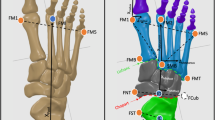Abstract
The energy storage capacity of the human foot as a passive structure depends on both its geometry and elastic properties. The present study examines theoretically the relationship between the energy stored in the longitudinal arch and the inclination of the calcaneus, when a vertical load is applied. A simple two-dimensional model was used, consisting of two inclined rigid elements, hinged at the apex of the arch and connected by a horizontal tension spring at the bottom of the arch. The spring serves as the energy-storing element of the model, representing the foot plantar ligaments. The behaviour of the model was examined using both a linear and an exponential spring. It demonstrated that the stored energy depends strongly on the calcaneal inclination. For a given vertical load, the energy storage capacity is low at both large and small inclinations and rises markedly at an intermediate value. Assuming that the incidence of stress fractures during locomotion is affected by insufficient energy attenuation of the foot, this model provides an explanation for the higher prevalence of tibial and femoral stress fractures in subjects with high or low arches.
Similar content being viewed by others
References
Fung, Y. C. (1980) Behaviour of tissues under uniaxial loading. InBiomechanics, mechanical properties of living tissues. Springer Verlag, New York, 219–226.
Hicks, J. H. (1955) The foot as a support.Acta Anat.,25, 34–45.
Hicks, J. H. (1961) The three weightbearing mechanisms of the foot. InBiomechanical studies of the musculoskeletal system.Evans, F. G. (Ed.), Charles C. Thomas, 161–191.
Ker, R. F., Bennet, M. B., Bibby, S. R., Kester, R. C., Alexander, R. McN. (1987) The spring in the arch of the human foot.Nature,325, 147–149.
Lapidus, P. W. (1943) Misconception about the ‘springiness’ of the longitudinal arch of the foot (mechanics of the arch of the foot).Arch. Surg.,46, 410–421.
Matheson, G. O., Clement, D. B., McKenzie, D. C., Taunton, J. E., Lloyd-Smith, D. R. andMacClintyre, J. G. (1987) Stress fractures in athletes—a study of 320 cases.Am. J. Sports Med.,15, 46–58.
McMahon, T. (1987) The spring in the human foot.Nature,325, 108–109.
Milgrom, C., Giladi, M., Stein, M., Kashtan, H., Marguiles, J. Y., Chisin, R., Steinberg, R. andAharonson, Z. (1985) Stress fractures in military recruits—a prospective study showing an unusually high incidence.J. Bone & Joint Surg.,67B, 732–735.
Salathe, E. P. Jr., Arangio, G. A. andSalathe, E. P. (1986) A biomechanical model of the foot.J. Biomech.,19, 989–1001.
Simkin, A., Arcan, M. andBrull, M. (1985) A structural model of the human foot. InBiomechanics: current interdisciplinary research.Perren, S. M. andSchneider, E. (Eds), Martinus Nijhoff Publishers, 339–344.
Simkin, A., Leichter, I., Giladi, M., Stein, M. andMilgrom, C. (1989) The combined effect of foot arch structure and an orthotic device on stress fractures.Foot & Ankle,10, 25–29.
Sullivan, D., Warren, R. F., Pavlov, H. andKelman, G. (1984) Stress fractures in 51 runners.Clin. Orthop.,187, 188–192.
Wright, D. G. andRennels, D. C. (1964) A study of elastic properties of plantar fascia.J. Bone & Joint Surg.,46A, 482–492.
Author information
Authors and Affiliations
Rights and permissions
About this article
Cite this article
Simkin, A., Leichter, I. Role of the calcaneal inclination in the energy storage capacity of the human foot—a biomechanical model. Med. Biol. Eng. Comput. 28, 149–152 (1990). https://doi.org/10.1007/BF02441770
Received:
Accepted:
Issue Date:
DOI: https://doi.org/10.1007/BF02441770




